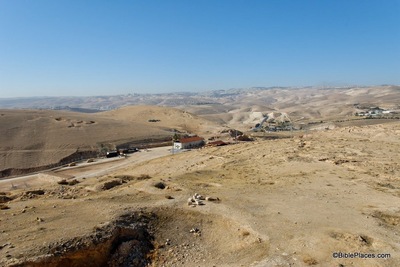
If you visit the Holy Land, there is a museum that opened about a year ago that is getting a lot of attention, and attracting a lot of visitors. It stands on the road between Jerusalem and Jericho – the very same road mentioned in today’s gospel. The museum holds various religious artifacts and mosaics. But what may be most intriguing is that it sits atop an archeological dig. Beneath the museum is the foundation of an ancient inn – dating back to the Byzantine era, and possibly even beyond. The museum’s name says it all: it’s called the Inn of the Good Samaritan.
Which leads me to wonder: where did the parable in today’s gospel come from? Could it have a basis in truth? Did Jesus witness some act of kindness like that, or hear about it?
It’s impossible to know. And, of course, it’s not important if the story is literally true. Because what matters in the parable of the Good Samaritan is the larger truth it reveals about Christ’s message, and the answer to the haunting question, “Who is my neighbor?”
This, along with the Prodigal Son, stands as one of the most beautiful and enduring stories in the gospel. We know it so well, it’s a part of our language. “The Good Samaritan” is synonymous with charity, and mercy. Countless hospitals are known by that name. Google the phrase “Good Samaritan” and you’ll get nearly four million entries. It’s so familiar to us, we may feel like we know this parable by heart, and its overriding moral: the call to compassion, and kindness, and solidarity with all those who suffer.
And we all know the characters involved, too: the helpless, bloodied victim by the side of the road, the Levite and the priest, and of course, the Samaritan whose generous heart earns him the title of “Good.”
But I’d like to propose another way of approaching this parable.
For as much as the parable of the “Good Samaritan” is about different characters and types, it is also about something else.
It is also about the road.
It is about traveling a dangerous and difficult route, through sometimes unfamiliar territory. It is about the pain we encounter, and the suffering we endure. It is about the unexpected – what happens to us, and to those we meet.
Ultimately, I think, “The Good Samaritan” is about a journey — and the choices we make along the way.
You see, this story is a parable not just about thoughtfulness and compassion. “The Good Samaritan” is also a parable about life, and how we live it.
Here is the human adventure, the human experience, along a twisting road from Jerusalem to Jericho.
We may not realize it, but it is a road all of us travel at one time or another. We are all on that journey. In the parable, the places of departure and arrival aren’t that important – significantly, we’re never told if the characters actually reach their final destination.
What matters, instead, is the journey.
And what matters on the journey – our journey — is those we encounter along the way. How do we treat them? Do we notice them? Do we avoid them? Do we act like they don’t exist?
Or: do we see them, with all their wounds and scars, and see a neighbor in need?
Do we, perhaps, even see ourselves?
Because we all have wounds. And we all need shelter. That place might be an inn. It might be a church. It might be the sheltering arms of friendship, or family. Or it might not be a place at all. Sometimes the sturdiest walls are made of mercy, and the strongest roof is constructed of love. That is the most beautiful shelter of all.
Those stopping places, those shelters, are also part of the journey.
And so are the choices we make along the way. A choice to stand on the sidelines — or to get involved. A choice to stay in our comfort zones – or take a risk. A choice to keep on going – or to stop, bend over, and bandage the wounds of another.
Preparing this homily, and reading about this parable, I discovered that the “Good Samaritan” was a favorite of Dr. Martin Luther King, Jr. He actually spoke about it the night before he was killed, as part of his speech in which he talked about going to the mountaintop.
He framed the parable in a beautiful and very human way. The way Dr. King put it: “The first question that the priest asked, the first question that the Levite asked was, ‘If I stop to help this man, what will happen to me?” But then the Good Samaritan came by and turned the question around. ‘If I do NOT stop to help this man, what will happen to HIM?”
That, I think, is the hallmark of true compassion. That is true Christian love. And that is how we are all called to respond to those we encounter on our road, on our journey, to whatever destination we might be headed.
As Jesus says at the end of the story: “Go and do likewise.” The Inn of the Good Samaritan awaits us.
He is telling us to go and be merciful. Go and care. Go and burden yourself with the problems of a stranger.
But go. Follow the unpredictable road that is life. Risk encountering what you don’t want to see. Leave your comfort zone. Dare to engage yourself in the struggles of another.
Dare to love.
The last words of the parable are Christ’s instructions to a world that is often too timid, too indifferent, too cautious, or too frightened. Get over all that, Jesus says. Begin the journey. Leave your own Jerusalem, and journey to Jericho, with a heart that can be moved to compassion.
The Samaritan did that, and saved a life – and very likely saved his own
soul.
Go, Jesus says. Go and do likewise.
Related: Homily for this Sunday from 2007.

